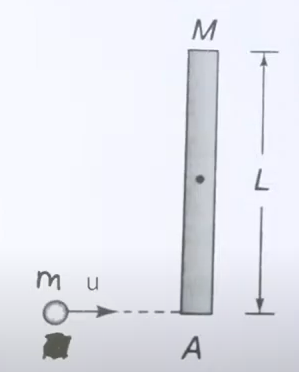A ball of mass m moving with a speed u0 collides elastically with a rod of mass M suspended in the vertical plane by the hinge O. The rod is free to rotate in the vertical plane. Before and after the collision.

Linear momentum of the ball and rod system is conserved
Linear momentum of the ball and rod system is conserved only when the collision is elastic
Linear momentum of the ball and rod system may be conserved for a particular value of x.
none of these
The correct Answer is:C
Topper's Solved these Questions
- BOOK - FIITJEECHAPTER - KINEMATICSEXERCISE - SECTION (II) : (SUBJECTIVE )33videos
KINEMATICS
- BOOK - FIITJEECHAPTER - KINEMATICSEXERCISE - SECTION(II) : MCQ ( SINGLE CORRECT)47videos
KINEMATICS
- BOOK - FIITJEECHAPTER - KINEMATICSEXERCISE - NUMERICAL BASED QUESTIONS3videos
KINEMATICS
- BOOK - FIITJEECHAPTER - HEAT AND TEMPERATUREEXERCISE - NUMERICAL BASES QUESTIONS1videos
HEAT AND TEMPERATURE
- BOOK - FIITJEECHAPTER - LAWS OF MOTIONEXERCISE - COMPREHENSION-III2videos
LAWS OF MOTION
Similar Questions
A particle of mass m moving with speed V collides elastically with another particle of mass 2m. Find speed of smaller mass after head on collision
View SolutionA ball of mass m moving with a speed u1 collides elasticity with another identical ball moving with velocity u2.
(a) Find the velocities of the balls after collision if the impact is direct.
(b) Find the angle between velocities after collision if they collide obliquely and u2=0View Solution
Knowledge Check
- Question 1 - Select One
A rod is hinged vertically at one end and is forced to oscillate in a vertical plane with hinged end at the top, the motion of the rod:
Ais simple harmonicBis oscillatory but not simple harmonicCis pericolic but not oscillatoryDmay be simple harmonic - Question 2 - Select One
Body A of mass 4m moving with speed u collides with another body B of mass 2m at rest the collision is head on and elastic in nature. After the collision the fraction of energy lost by colliding body A is :
A59B19C89D49
A particle of mass m and speed u collides elastically with the end of a uniform rod of mass M and length L as shown. If the particle comes to rest after collision, find mM
 View Solution
View SolutionA particle of mass m moving with velocity u collides elastically head on with a particle of mass 2m at rest. After collision the heavier particle moves with velocity?
View SolutionA uniform rod of mass m and length l is fixed from Point A, which is at a distance l/4 from one end as shown in the figure. The rod is free to rotate in a vertical plane. The rod is released from the horizontal position.

What is the reaction at the hinge, when kinetic energy of the rod is maximum?View SolutionTwo identical unifrom rods OA and OB each of length l and mass m are connected to each other by a massless pin connection (both the rods can rotate about O which is free to move), that allows free rotation. The assembly is kept on a frictionless horizontal plane. Now two point masses each of mass m moving with speed u perpendicular to the AB and hit the assembly inelastically at points A and B as shown in the figure.

The speed of the centre of mass of the whole assembly just after the collision will beView SolutionTwo identical unifrom rods OA and OB each of length l and mass m are connected to each other by a massless pin connection (both the rods can rotate about O which is free to move), that allows free rotation. The assembly is kept on a frictionless horizontal plane. Now two point masses each of mass m moving with speed u perpendicular to the AB and hit the assembly inelastically at points A and B as shown in the figure.

The speed of the centre of mass of the whole assembly just after the collision will beView SolutionBody A of mass 4m moving with speed u collides with another body B of mass 2m at rest the collision is head on and elastic in nature. After the collision the fraction of energy lost by colliding body A is :
View Solution

